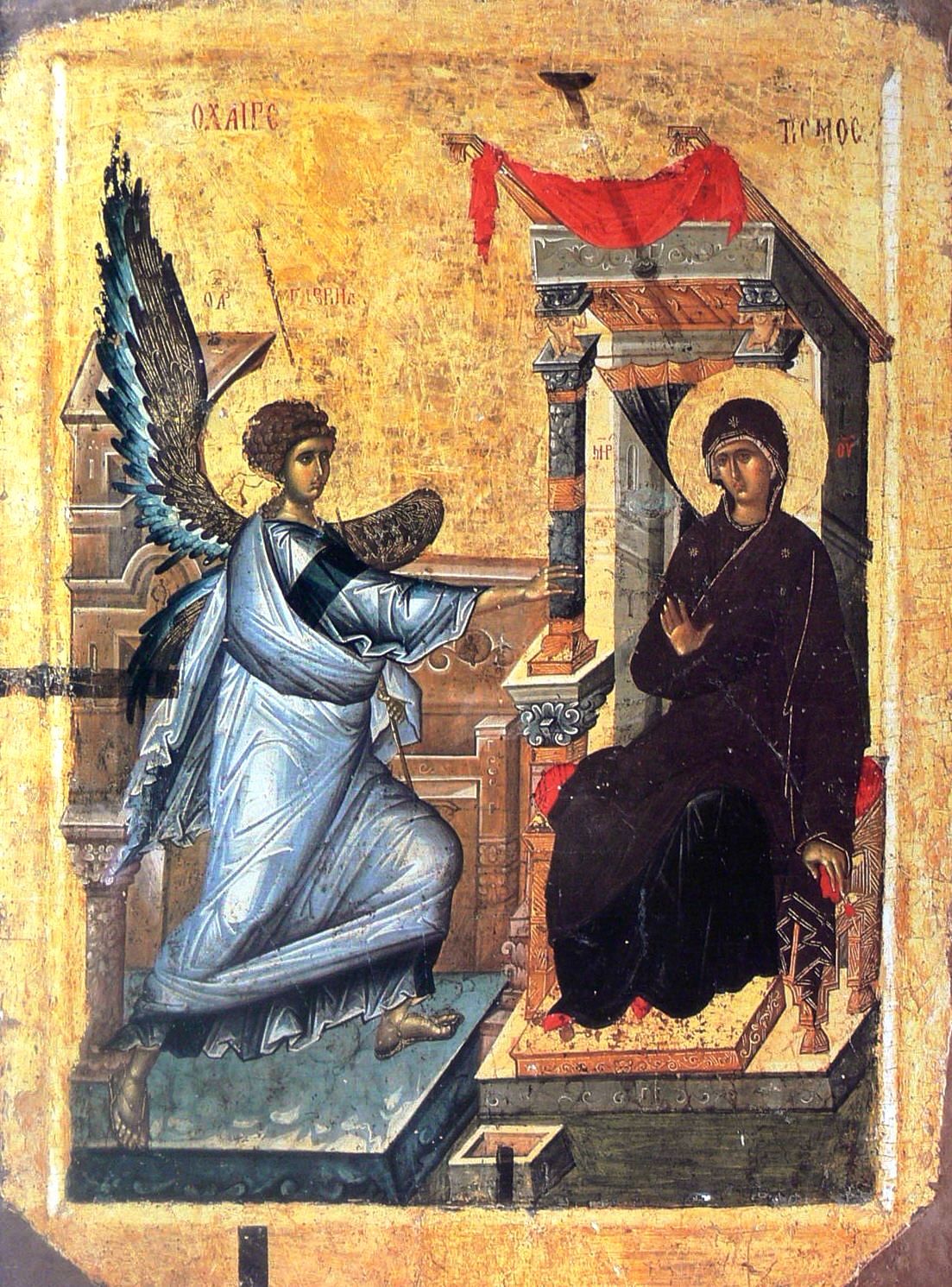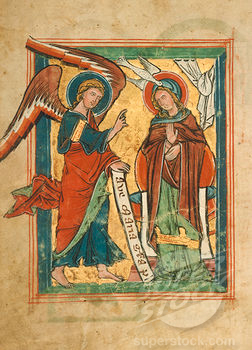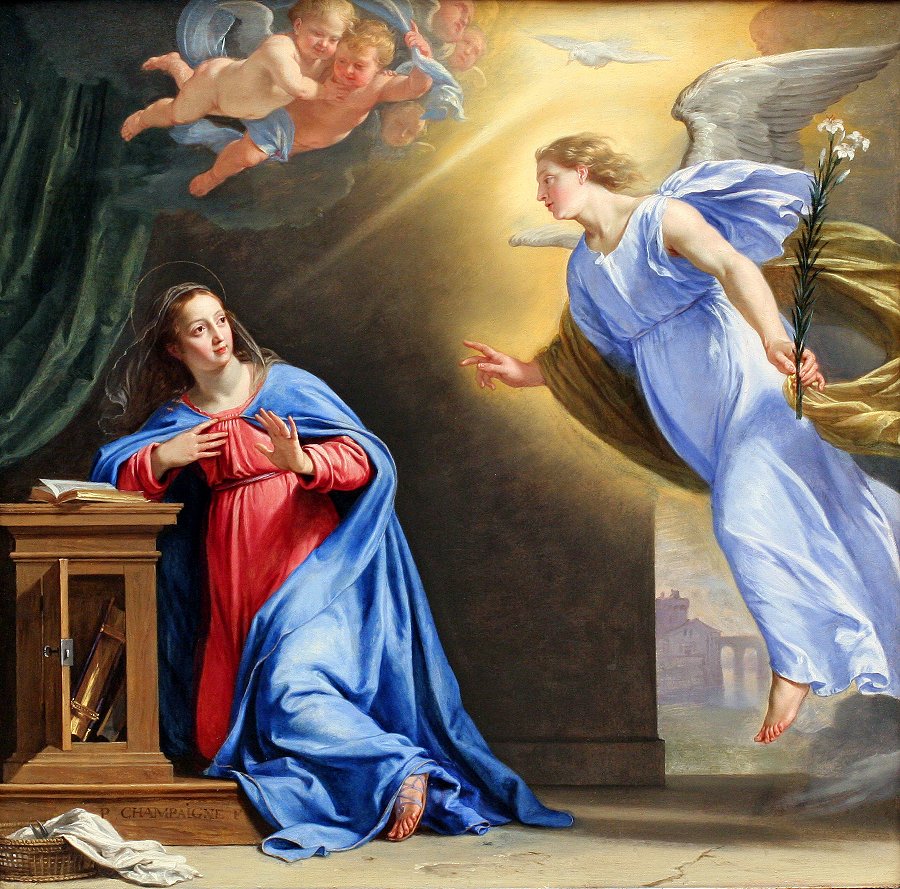 I was recently asked a question about the fact that many icons of the Annunciation portray our lady holding a scarlet or purple thread. This reflects a detail that comes from one of the apocryphal gospels the Protevangelium of James. The Catholic Encyclopedia describes it as follows: “It purports to have been written by ‘James the brother of the Lord’, i.e. the Apostle James the Less. It is based on the canonical Gospels which it expands with legendary and imaginative elements, which are sometimes puerile or fantastic. The birth, education and marriage of the Blessed Virgin are described in the first eleven chapters and these are the source of various traditions current among the faithful. They are of value in indicating the veneration paid to Mary at a very early age. For instance it is the "Protoevangelium" which first tells that Mary was the miraculous offspring of Joachim and Anna, previously childless; that when three years old the child was taken to the Temple and dedicated to its service, in fulfilment of her parents’ vow. When Mary was twelve Joseph is chosen by the high-priest as her spouse in obedience to a miraculous sign — a dove coming out of his rod and resting on his head.”
In regard to this particular detail, according to the Protevangelion when Gabriel entered Mary’s house to announce the joyous news of the Incarnation of the Logos, she was spinning purple and scarlet thread to make a veil for the temple. She was chosen because she was a virgin. Mary with this detail therefore to emphasize her virginity. If purple is shown, it signifies also her descent from the royal house of David. If Mary is shown holding scarlet thread, the colour of blood, then this signifies the fact that the Saviour took flesh and blood from her flesh and blood.
I was recently asked a question about the fact that many icons of the Annunciation portray our lady holding a scarlet or purple thread. This reflects a detail that comes from one of the apocryphal gospels the Protevangelium of James. The Catholic Encyclopedia describes it as follows: “It purports to have been written by ‘James the brother of the Lord’, i.e. the Apostle James the Less. It is based on the canonical Gospels which it expands with legendary and imaginative elements, which are sometimes puerile or fantastic. The birth, education and marriage of the Blessed Virgin are described in the first eleven chapters and these are the source of various traditions current among the faithful. They are of value in indicating the veneration paid to Mary at a very early age. For instance it is the "Protoevangelium" which first tells that Mary was the miraculous offspring of Joachim and Anna, previously childless; that when three years old the child was taken to the Temple and dedicated to its service, in fulfilment of her parents’ vow. When Mary was twelve Joseph is chosen by the high-priest as her spouse in obedience to a miraculous sign — a dove coming out of his rod and resting on his head.”
In regard to this particular detail, according to the Protevangelion when Gabriel entered Mary’s house to announce the joyous news of the Incarnation of the Logos, she was spinning purple and scarlet thread to make a veil for the temple. She was chosen because she was a virgin. Mary with this detail therefore to emphasize her virginity. If purple is shown, it signifies also her descent from the royal house of David. If Mary is shown holding scarlet thread, the colour of blood, then this signifies the fact that the Saviour took flesh and blood from her flesh and blood.
 The portrayal of Mary weaving began to occur about the fifth century onwards with basket and bobbin of thread. From about the ninth century onwards, the basket seems to have been omitted. The portrayal of the Annunciation in the West, seems to be less consistent in including this. I have shown a Spanish Romanesque painting that has Our Lady with thread, but not scarlet or purple. El Greco and de Champagne, in quite different styles, show a basket of cloth, but containing white material. The final image by Guido Reni has no illusion to the making of the temple veil at all that I can see.
The portrayal of Mary weaving began to occur about the fifth century onwards with basket and bobbin of thread. From about the ninth century onwards, the basket seems to have been omitted. The portrayal of the Annunciation in the West, seems to be less consistent in including this. I have shown a Spanish Romanesque painting that has Our Lady with thread, but not scarlet or purple. El Greco and de Champagne, in quite different styles, show a basket of cloth, but containing white material. The final image by Guido Reni has no illusion to the making of the temple veil at all that I can see.
How do we make sense of this? In regard to apocryphal writings, The Catholic Encyclopedia makes the point that it need not be a negative term, and can be interpreted as simply, non canonical. (No writings that are in the bible, therefore, New or Old Testament, should ever be referred to as apocryphal). Some apocryphal writings can be useful and some are heretical. I certainly do not feel qualified to sift through these documents and the supporting research which decides which are valid and which are not. For the most part, when there are details included that are not scriptural and which I do not understand, if they appear regularly make an effort to understand why they are there. If I cannot get to the root of them I do not include them. In this case, given that there is a long history of its inclusion and it does seem to have accepted as valid, I might include it if asked. Given that the source is non scriptural I my instincts are not strongly in favour and it would need to be well and truly embedded in tradition for me to consider it. One thing I won’t be doing is reading these documents in detail with a view to using them as a potential source for new symbols.
The Western portrayals often show Mary reading scripture opened to the prophecy of Isaiah: “Behold a virgin shall conceive and bear a son...” (Isaiah 7:14). Given the scriptural reference, my personal instincts tend towards favour this form.
Above: 13th century iconographic (Romanesque) Annunciation consistent with the iconographic style; and below by El Greco, de Champagne and Guido Reni respectively.





